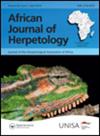Testing the thermal melanism hypothesis for Cape Cobras ( Naja nivea ) using community science photographic data
IF 0.9
4区 生物学
Q2 Agricultural and Biological Sciences
引用次数: 0
Abstract
ABSTRACTAnimal colour is a highly adaptive phenotypic trait that can respond to several selection pressures, including those facilitated by variations in climate. The thermal melanism hypothesis predicts that for ectotherms, selection for darker phenotypes should be highest in cooler areas because darker pigmentation should provide thermoregulatory advantages. We tested whether intraspecific variation in colour distribution of Cape Cobras (Naja nivea) conforms to this hypothesis using a dataset of ∼800 georeferenced photographs of cobras available from community science platforms. We scored the dorsal colouration of snakes in each photograph and tested for associations between snake colours and climate variables at those locations. Our results provide strong evidence to suggest that temperature and solar radiation are important predictors of N. nivea colour occurrence, whereas elevation and precipitation are not. Overall, darker snakes have a significantly higher probability of occurrence in colder areas with low solar radiation than lighter snakes, which are more likely to occur in hotter areas with more solar radiation. Our study is the first to provide evidence for thermal melanism in a sub-Saharan African snake species, which was made possible by the availability of community science data.KEYWORDS: Cape Cobraclimatecolour variationsnakesthermal melanism AcknowledgementsWe thank Darren Pietersen and Rene Navarro for facilitating availability of reptileMAP data. We thank Tyrone Ping and Johan Marais for allowing us to use their photographs. Lastly, we thank the various contributors who uploaded their observations of cape cobras on community science platforms.Data availabilityData and code to perform analyses are available on Figshare (https://doi.org/10.6084/m9.figshare.23774586).使用社区科学摄影数据测试角眼镜蛇(Naja nivea)的热黑变假说
摘要动物颜色是一种高度适应性的表型特征,可以对多种选择压力做出反应,包括气候变化所促进的压力。热黑变假说预测,对于变温动物来说,在较冷的地区,对深色表型的选择应该是最高的,因为深色的色素沉着应该提供热调节优势。我们测试了角眼镜蛇(Naja nivea)颜色分布的种内变化是否符合这一假设,使用了来自社区科学平台的约800张眼镜蛇地理参考照片的数据集。我们对每张照片中蛇的背部颜色进行了评分,并测试了蛇的颜色与这些地点的气候变量之间的联系。我们的结果提供了强有力的证据,表明温度和太阳辐射是重要的预测因子,而海拔和降水不是。总的来说,深色蛇在太阳辐射较低的寒冷地区出现的可能性明显高于浅色蛇,浅色蛇更有可能出现在太阳辐射较强的炎热地区。我们的研究首次为撒哈拉以南非洲蛇类的热黑病提供证据,这是由于社区科学数据的可用性而成为可能的。我们感谢Darren Pietersen和Rene Navarro为爬虫类map数据的获取提供了便利。我们感谢Tyrone Ping和Johan Marais允许我们使用他们的照片。最后,我们感谢在社区科学平台上上传他们对角眼镜蛇的观察的各种贡献者。数据可用性执行分析的数据和代码可在Figshare (https://doi.org/10.6084/m9.figshare.23774586)上获得。
本文章由计算机程序翻译,如有差异,请以英文原文为准。
求助全文
约1分钟内获得全文
求助全文
来源期刊
CiteScore
2.60
自引率
6.70%
发文量
0
审稿时长
>12 weeks
期刊介绍:
African Journal of Herpetology (AJH) serves as an outlet for original research on the biology of African amphibians and reptiles. AJH is an interdisciplinary journal that publishes original articles and reviews from diverse fields and disciplines, such as conservation, phylogenetics, evolution, systematics, performance, physiology, ecology, behavioural ecology, ethology, and morphology.
The Journal publishes two issues a year. There are no page charges .

 求助内容:
求助内容: 应助结果提醒方式:
应助结果提醒方式:


